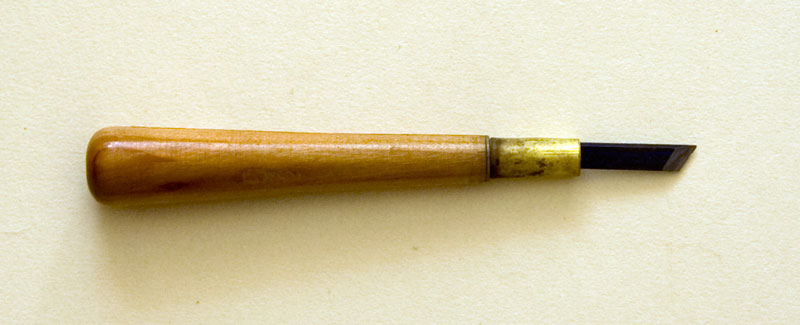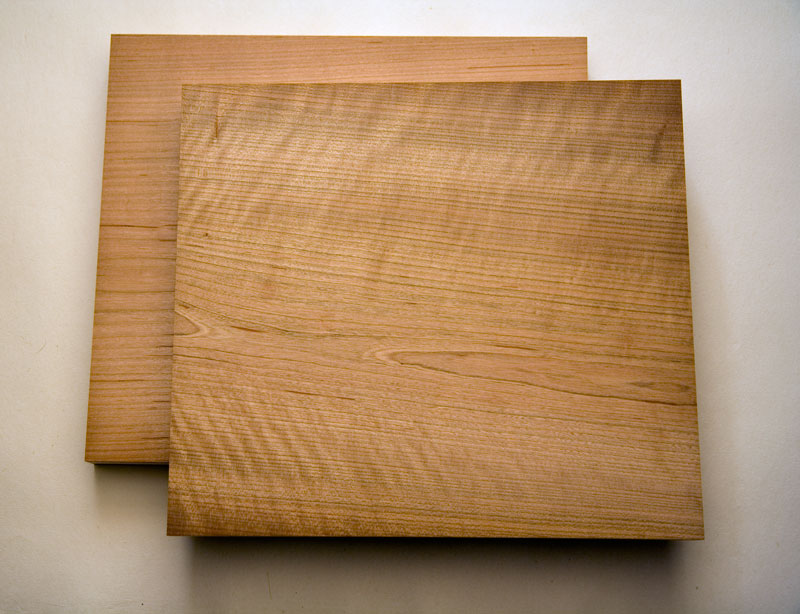Carving tools and materials
Click on any image to obtain a larger view of the corresponding tool(s) and/or material(s).
| Character | Reading | Meaning | Translation |
| 版 | han | printing | |
| 木 | ki | wood | |
| 刀 | tō | knife | hangi-tō, meaning ‘‘woodblock carving knife’’ |
The first step in any classic Japanese woodblock carving project (whether it concerns the key-block or one or more of the colour-blocks) is to cut out its lines (if it is the key-block) or its colour outlines (if it is a colour-block). This is typically done with the hangi-tō or carving knife:

|
This carving knife can be obtained in a range of blade sizes, the hangi-tō shown here being of the standard 6 mm variety. Just like those famous Japanese samurai swords, Japanese woodblock carving knifes and chisels are made by welding and laminating two types of metal together: steel to obtain a sharp edge, and wrought iron to make the blade more solid and less elastic.
| Character | Reading | Meaning | Translation |
| 浅 | asa | shallow | |
| 丸 | maru | round | |
| のみ | nomi | chisel | asagata-maru-nomi, which loosely translates into ‘‘shallow-round large-area clearing chisel’’ |
| 惣 | sō | ||
| 合 | wasu | put together | |
| のみ | nomi | chisel | sōai-nomi, loosely translating into ‘‘bull-nosed large-area clearing chisel’’ |
The next step is to clear the large wooden areas further removed from these lines with the asagata-maru-nomi and sōai-nomi carving tools, usually handled with a wooden mallet:

|
The respective blade sizes of these asagata-maru-nomi and sōai-nomi carving tools are 15 and 24 mm.
| Character | Reading | Meaning | Translation |
| 間 | aida | interval | |
| 透 | su(keru) | leave a space | ai-suki, loosely translating into ‘‘bull-nosed small-area clearing chisel’’ |
The third and final step consists of clearing away the smaller wooden areas remaining between the lines left standing and cut with the hangi-tō, and the large wooden areas previously removed with the asagata-maru-nomi and sōai-nomi carving tools. This is achieved with a range of aisuki carving tools:

|
The blade sizes of the tools displayed in this picture are 1 mm (top), 3 mm (middle), and 4.5 mm (bottom). As the bottom aisuki illustrates, the wooden holder of each one of these chisels can be opened in order to extend their use until the carving blade has been utterly spent, in which case it can be replaced with a brand new blade.
| Character | Reading | Meaning | Translation |
| 仕 | shi | serve | |
| 上 | a(geru) | raise | |
| 研 | to | sharpen | shiage-to, meaning ‘‘fine whet-stone’’ |
| 中 | chū | middle | |
| 研 | to | sharpen | chū-to, meaning ‘‘medium whet-stone’’ |
| 荒 | ara | rough | |
| 研 | to | sharpen | ara-to, meaning ‘‘rough whet-stone’’ |
All these carving knifes and chisels can be honed with the following dedicated fine (left), medium (middle), and rough (right) Japanese sharpening stones:

|
| Character | Reading | Meaning | Translation |
| 山 | yama | mountain | |
| 桜 | sakura | cherry tree | wild cherry |
Especially when it comes to fine-line carving, woodblocks are preferably made from the wood of a special type of wild Japanese cherry (Prunus serrulata). Japanese woodblocks are typically cut with the grain of the wood (and not against it). Here are two plywood blocks whose top and bottom layers consist of yamazakura, ready for carving:

|
Although not apparent from the image, the surfaces of these blocks are incredibly smooth: they have been chiselled and sanded so perfectly that when stacked on top of each other it takes some effort to pull them apart ...
Provenance of these tools and materials: the websites of McClains, Matsumura-san, and the Baren Mall